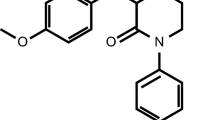Abstract
Unlike other classic NSAIDs, some fenamates given at therapeutic concentrations, have been shown to inhibit, bothin vitro andin vivo, the 5-lipoxygenase pathway of arachidonic acid cascade as well as the synthesis of cyclooxygenase products. This dual inhibitory property might represent an improvement in anti-inflammatory therapy. The aim of this work was to characterize the effect of morniflumate, admistered at therapeutic dosages to normal human volunteers, on leukotriene B4 (LTB4) and thromboxane (TXB2) synthesis, both in purified PMNs and in whole blood. PMNs, isolated two hours after a single oral administration of morniflumate and at steady-state condition, fully retain their capacity to release LTB4 and TXB2. Since intracellular concentrations of the drug were undetectable, in spite of its elevated concentrations in platelet poor plasma, the results obtained using PMNs suggest a drug loss during the cells purification procedure. In whole blood experiments, morniflumate reduced blood LTB4 synthesis induced by Ca-ionophore A23187 Bx approximately 50%, both after single dose and at steady state; the degree of inhibition showed a pattern similar to the plasma levels of the bioactive metabolite of morniflumate (M1). The inhibition of serum TXB2 levels was higher than 85%. Hence, morniflumate is capable of reducing arachidonic acid metabolism acting both on cyclooxygenase and 5-lipoxygenase. This characteristic might provide a better approach in anti-inflammatory therapy.
Similar content being viewed by others
References
A. Higgs, S. Moncada and J. R. Vane,Eicosanoids in inflammation. Ann. Clin. Res.16, 287–299 (1984).
P. J. Piper,Formation and actions of leukotrienes. Physiol. Rev.64, 744–761 (1984).
B. Samuelsson, S. Hammarstrom, R. C. Murphy and P. Borgeat,Leukotrienes and slow reacting substance of anaphylaxis (SRS-A). Allergy35, 375–381 (1980).
J. Alanko, E. Moilanen, J. Opas and H. Vapaatalo,Tolfenamic acid inhibits leukotriene synthesis in human granulocytes. Agents and Actions26, 254–255 (1989).
E. Moilanen, J. Alanko, A. Juhakoski and H. Vapaatalo,Orally administered tolfenamic acid inhibits leukotriene synthesis in isolated human peripheral polymorphonuclear leukocytes. Agents and Actions28, 83–88 (1989).
P. Gresele, J. Arnout, M. C. Coene, H. Deckmyn and J. Vermylen,Leukotriene B 4 production by stimulated whole blood: comparative studies with isolated polymorphonuclear cells. Biochem. Biophys. Res. Comm.137, 334–342 (1986).
A. Boyum,Isolation of lymphocytes, granulocytes and macrophages. Scand. J. Immunol. Suppl.5, 9–15 (1976).
R. B. Zurier, S. Hoffstein and G. Weissmann,Mechanism of lysosomal enzyme release from human leukocytes. J. Cell Biol.58, 27–41 (1973).
P. Pradelles, J. Grassi and J. Maclouf,Enzyme immunoassay of eicosanoids using AchE as label: an alternative to RIA. Anal. Biochem.57, 1170–1173 (1985).
J. A. Salmon, P. M. Simmons and R. M. J. Palmer,A radioimmunoassay for leukotriene B 4. Prostaglandins24, 225–235 (1982).
S. Moncada,Prospects for inhibition of leukotriene biosynthesis. InThe leukotrienes. (Ed. P. J. Piper) pp. 99–107, Raven Press, New York 1986.
N. R. Ackerman, E. C. Arner, W. Galbraith, R. R. Harris, B. D. Jaffee and W. M. Mackin,Anti-inflammatory consequences of 5-lipoxygenase inhibition. Adv. Prostaglandin Thromboxane Leukotriene Res.16, 47–62 (1986).
A. W. Ford-Hutchinson, M. A. Bray, M. V. Doig, M. E. Shipley, and M. J. H. Smith,Leukotriene B 4:a potent chemokinetic and aggregating substance released from polymorphonuclear leukocytes. Nature286, 264–265 (1980).
S. E. Dahlen, J. Bjork, P. Hedqvist, K. E. Argos, S. Hammarstrom, J. A. Lindgren and B. Samuelsson,Leukotrienes promote plasma leakage and leukocyte adhesion in postcapillary venules: in vivo effects with relevance to the acute inflammatory response. Proc. Natl. Acad. Sci. USA78, 3887–3891 (1981).
M. A. Bray,Leukotrienes in inflammation. Agents and Actions19, 87–99 (1986).
T. J. Williams and M. J. Peck,Role of prostaglandin-mediated vasodilation in inflammation. Nature1, 530–533 (1977).
T. J. Williams and P. J. Piper,The action of chemically pure SRS-A on the microcirculation in vivo. Prostaglandins19, 779–789 (1980).
R. Fruchtmann, U. Krupka and B. Pelster,Hemmung des Lipoxygenase und Cyclooxygenaseweges in Arachidonsäure-metabolismus durch Etofenamat. Akt. Rheumatol.9, 165–168 (1984).
A. M. Boctor, M. Eickholt and T. A. Pugsley,Meclofenamate sodium is an inhibitor of both the 5-lipoxygenase and cyclooxygenase pathways of the arachidonic cascade in vitro. Prostaglandins Leukotrienes Med.23, 229–238 (1986).
P. W. Lucker and H. Werner,Valutazione della tollerabilita′ gastrica di morniflumato mediante misurazione del potenziale transmurale gastrico. Clinica Europea29, 62–66 (1990).
S. Cadel, S. Bongrani, D. Acerbi and T. Vigano,Morniflumato, un farmaco antiinfiammatorio non steroideo provvisto di attivita' gastroprotettiva. Clinica Europea29, 27–43 (1990).
K. D. Rainsford and M. W. Whitehouse,Anti-inflammatory/anti-pyretic salicylic acid esters with low gastric ulcerogenic activity. Agents and Actions10, 451–456 (1980).
M. W. Whitehouse and K. D. Rainsford,Esterification of acidic anti-inflammatory drugs suppresses their gastrotoxicity without adversely affecting their anti-inflammatory activity in rats. J. Pharm. Pharmac.32, 795–796 (1980).
A. Dembinska-Kiec, B. A. Peskar, M. K. Müller and B. M. Peskar,The effect of platelet-activating factor on flow rate and eicosanoid release in the isolated perfused rat gastric vascular bed. Prostaglandins3, 69–76 (1989).
B. M. Peskar,Cysteinyl leukotrienes in experimental ulcers in rats. InLeukotrienes and prostanoids in health and disease. Vol. 3 (Eds. U. Zor, Z. Naor, A. Danon) pp. 225–230, Karger, Basel 1989.
J. R. Whittle, N. Oren-Wolman and P. H. Guth,Gastric vasocoustrictor actions of leukotriene C 4,PGF 2α and thromboxane mimetic U-46619 on rat submucosal microcirculation in vivo. Am. J. Physiol.248, G580 (1985).
G. Pihan, C. Rogers and S. Szabo,Vascular injury in acute gastric mucosal damage. Mediatory role of leukotrienes. Dig. Dis. Sci.33, 625–632 (1988).
S. J. Konturek, T. Brozowski, D. Drozdowicz and G. Beck,Role of leukotrienes in acute gastric lesions induced by ethanol, taurocholate, aspirin, platelet-activating factor and stress in rats. Dig. Dis. Sci.33, 806–813 (1988).
Author information
Authors and Affiliations
Rights and permissions
About this article
Cite this article
Civelli, M., Vigano, T., Acerbi, D. et al. Modulation of arachidonic acid metabolism by orally administered morniflumate in man. Agents and Actions 33, 233–239 (1991). https://doi.org/10.1007/BF01986568
Received:
Accepted:
Issue Date:
DOI: https://doi.org/10.1007/BF01986568




